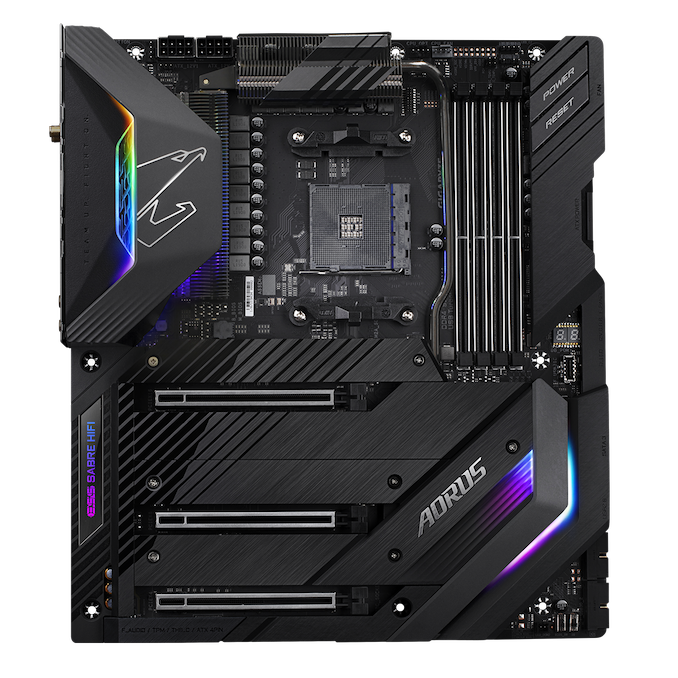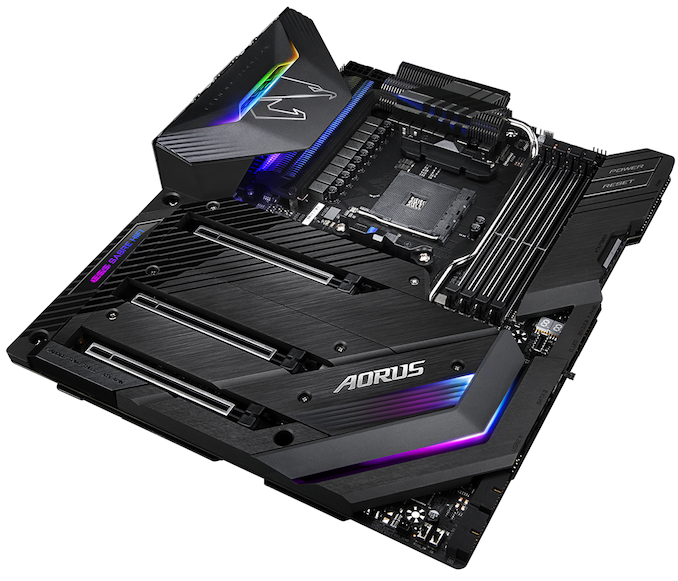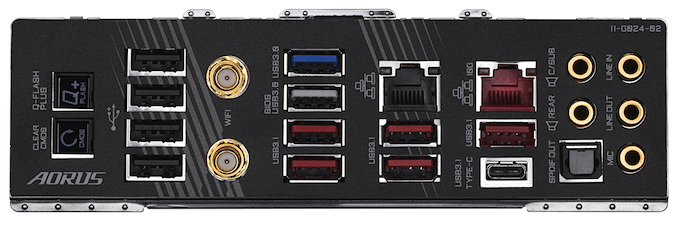The AMD X570 Motherboard Overview: Over 35+ Motherboards Analyzed
by Gavin Bonshor on July 9, 2019 8:00 AM ESTGIGABYTE X570 Aorus Xtreme
Moving onto GIGABYTE's launch day X570 product stack, and it seems to have upped the ante in a number of areas over the previous X470 generation of motherboards. Firstly, GIGABYTE has done a slightly different approach with its power delivery configurations; on paper, they look much higher spec than on previous AM4 models. One prime example of this is in the GIGABYTE X570 Aorus Xtreme which as it stands, is the brand's current flagship model, and is feature-packed with numerous premium componentry, as well as a beefy 16-phase power delivery for the CPU. The other unique feature for the X570 Aorus Xtreme is it's currently the only X570 model at launch to passively cool the warm running X570 chipset.
The X570 Aorus Xtreme is the current flagship from GIGABYTE with a large looking 16-phase power delivery for users looking to overclock the latest Ryzen 3000 series processors, as well as a solid high-end feature set. Across the majority of the PCB, we get Aorus themed armor with three PCIe 4.0 x4 M.2 slots each with its own heatsink which moulds into the PCB cover. There are also six SATA ports with support for RAID 0, 1 and 10 arrays. The CPU VCore section of the power delivery uses two 8-pin 12 V CPU power inputs to deliver power to the processor.
The chipset heatsink onboard the X570 Aorus Xtreme is also one of the only models so far that relies on passive cooling which is interesting as we know the X570 chipset will run with two variants, an 11 W and 15 W. On the rear panel cover is an Aorus Falcon design, with multiple areas with RGB LEDs that users can customize with the Aorus RGB Fusion software. In the top right-hand corner is a power and reset switch, with a small debug LED, and front panel USB 3.1 G2 Type-C port. There are three full-length PCIe 4.0 slots with no PCIe 4.0 x1 slots featured on this model. One of the aspects GIGABYTE is known for focusing on with its high-end models is the onboard audio solution. Adding to the implementation of a Realtek ALC1220 HD audio codec is an ESS Sabre 9218 DAC, with WIMA audio capacitors.
On the rear panel is a large number of inputs and outputs which includes five USB 3.1 G2 Type-A, one USB 3.1 G2 Type-C, two USB 3.1 G1 Type-A, and four USB 2.0 ports. There are two antenna connectors for the integrated Intel AX200 Wi-Fi 6 802.11ax wireless interface, as well as two Ethernet ports which are powered by an Aquantia AQC107 10 G, and Intel I211-AT Gigabit NIC pairing. The Realtek ALC1220-VB HD audio codec adds five 3.5 mm audio jacks and an S/PDIF optical output. Also featured is a clear CMOS switch and Q-Flash Plus BIOS flashing button.
The GIGABYTE X570 Aorus Xtreme is a fine example of what vendors can do for its flagship models on the X570 chipset with plenty of USB 3.1 G2 ports on the rear panel. Dual networking with a 10 G NIC, Wi-Fi 6 capability, and 16-phase power delivery for the CPU make the X570 Aorus Xtreme very attractive. This model has an MSRP of $699 which represents the top end of the X570 product stack at launch, but with everything on offer, it was always expected to be expensive.













225 Comments
View All Comments
abufrejoval - Tuesday, July 9, 2019 - link
PCI4 and 5, or for that matter IF will trigger rethinking motherboard layouts and form factors."The [Enthusiast] motherboard" dates back to 1981 or the dawn of the IBM Personal Computer, and physics are catching up everywhere, even on the motherboard.
Distance has a huge impact on speed, latency and power, so 'flat' and 'square' are both the first obstacles and the first who need to compromise. In the future every milimeter of distance between the die carrier and your point of interest will need to be paid for, in energy/time or extra switching silicon.
Linear extrapolations of the past have little use, when the barriers are exponential.
TheUnhandledException - Tuesday, July 9, 2019 - link
Even if you keep the board a square moving the CPU and chipset to the center of the board and having PCIe slots on either side would cut the trace to the furthest slots in half.The_Assimilator - Wednesday, July 10, 2019 - link
Hopefully at the same time we can ditch 12V as the rail to rule them all, so that we can bring the amperages in current systems back down to sane levels.ChubChub - Friday, July 12, 2019 - link
Would be cool to see the CPU on one side of the board, and the cards on the other; would shrink those distances, but would require a new form factor, which would kindof suck (but I can picture what the dual-sided boards would look like, and I think it's a pretty neat idea having two independent sides for cooling (also, in a tower setup, a CPU sitting vertically on the board, which would be nice).Targon - Thursday, July 11, 2019 - link
This is why if Gen-Z gets adopted, we could have PCI Express hanging off the Gen-Z bus as a way to deal with these issues.sing_electric - Wednesday, July 10, 2019 - link
I was thinking that the mobo costs made price comparisons more difficult. Then I remembered that AMD is still throwing in a pretty good stock cooler, while Intel makes you BYO. For MOST users, that means that your total build cost will be lower with AMD.If you're doing something exotic - say, with liquid cooling or heavy overclocking that requires a certain thermal solution - then sure, you lose those savings, but if you're spending $300 to keep your machine cool, is the price difference of the motherboard really going to sway you one way or another?
Oliseo - Thursday, July 11, 2019 - link
You're actually comparing the bundled CPU cooler to a $300 custom loop Intel Cooler?You're expecting people to take you seriously as well?
Targon - Thursday, July 11, 2019 - link
Consider that for those who buy the i9-9900k, you can't get away with a 95W cooler, even if the rated TDP is 95W. So, you do need to buy at least a $30 cooler for air cooling on the 9900k, while AMD does provide a cooler to handle the typical performance of its processors. Even then, $330 for the Ryzen 7 3700X or 3800X for 8 cores/16 threads, vs. the $489 for the 9900k+$30 or $40 will still be more expensive for an 8 core/16 thread chip.What many don't realize is that if you go with AMD and get a B450 or X470 chipset motherboard(that has an updated BIOS or with BIOS flashback), you get the motherboard price you want, and the cost of ownership will still be lower. Since Intel doesn't offer PCI Express 4.0, going with PCI Express 3.0 on the AMD side won't be a big deal from the comparison point of view. Overclocking potential has not been compared between the enthusiast class X470 and X570 based motherboards from what I have seen as well, but it could make a difference for many people.
Flunk - Tuesday, July 9, 2019 - link
I like how almost all of these boards have 2 or more M.2 slots. I had to be very careful when I bought my Z170 board to find one with 3 M.2 slots.But now there are boards with 3 slots so maybe I'll have to snag that Aorus Ultra.
drexnx - Tuesday, July 9, 2019 - link
it's amazing how fast number of M.2 slots has become the primary thing I look for in a mobo anymore too